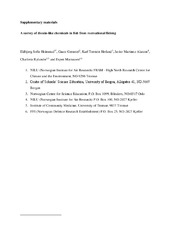Blar i forfatter "Heimstad, Eldbjørg Sofie"
-
Climate Performance, Environmental Toxins and Nutrient Density of the Underutilized Norwegian Orange-Footed Sea Cucumber (Cucumaria frondosa)
Langdal, Andreas; Eilertsen, Karl-Erik; Kjellevold, Marian; Heimstad, Eldbjørg Sofie; Jensen, Ida-Johanne; Elvevoll, Edel O. (Journal article; Tidsskriftartikkel; Peer reviewed, 2022-12-26)Low trophic species are often mentioned as additional food sources to achieve broader and more sustainable utilisation of the ocean. The aim of this study was to map the food potential of Norwegian orange-footed sea cucumber (Cucumaria frondosa). C. frondosa contained 7% protein, 1% lipids with a high proportion of polyunsaturated fatty acids, and a variety of micronutrients. The nutrient density ... -
Health and environmental impacts in the Norwegian border area related to local Russian industrial emissions. Knowledge status.
Sandanger, Torkjel Manning; Anda, Erik Eik; Berglen, Tore Flatlandsmo; Evenset, Anita; Christensen, Guttorm; Heimstad, Eldbjørg Sofie (Research report; Forskningsrapport, 2013)The contaminant situation in the Norwegian-Russian border has caused concern for several decades and considerable amount of data has been gathered during the Pasvik programme (Stebel et al., 2007; Pasvik programme, 2008) for the environmental pollution, but not in this extent for food safety and potential human health risks in this region. Through the compiling of the available literature the ... -
Homology modeling to screen for potential binding of contaminants to thyroid hormone receptor and transthyretin in glaucous gull (Larus hyperboreus) and herring gull (Larus argentatus)
Mortensen, Åse-Karen; Mæhre, Silje; Kristiansen, kurt; Heimstad, Eldbjørg Sofie; Gabrielsen, Geir W.; Jenssen, Bjørn Munro; Sylte, Ingebrigt (Journal article; Tidsskriftartikkel; Peer reviewed, 2020-01-11)Thyroid hormone disrupting chemicals (THDCs) are of major concern in ecotoxicology. With the increased number of emerging chemicals on the market there is a need to screen for potential THDCs in a cost-efficient way, and <i>in silico</i> modeling is an alternative to address this issue. In this study homology modeling and docking was used to screen a list of 626 compounds for potential thyroid hormone ... -
The impact of a Nickel-Copper smelter on concentrations of toxic elements in local wild food from the Norwegian, Finnish, and Russian border regions
Hansen, Martine Dalgaard; Nøst, Therese Haugdahl; Heimstad, Eldbjørg Sofie; Evenset, Anita; Dudarev, Alexey A.; Rautio, Arja; Myllynen, Päivi; Dushkina, Eugenia V.; Jagodic, Marta; Christensen, Guttorm N.; Anda, Erik Eik; Brustad, Magritt; Sandanger, Torkjel M (Journal article; Tidsskriftartikkel; Peer reviewed, 2017-06-28)Toxic elements emitted from the Pechenganickel complex on the Kola Peninsula have caused concern about potential effects on local wild food in the border regions between Norway, Finland and Russia. The aim of this study was to assess Ni, Cu, Co, As, Pb, Cd, and Hg concentrations in local wild foods from these border regions. During 2013–2014, we collected samples of different berry, mushroom, ... -
Mass Cultivation of Microalgae: I. Experiences with Vertical Column Airlift Photobioreactors, Diatoms and CO2 Sequestration
Eilertsen, Hans Christian; Eriksen, Gunilla; Bergum, John-Steinar; Strømholt, Jo; Elvevoll, Edel O.; Eilertsen, Karl-Erik; Heimstad, Eldbjørg Sofie; Giæver, Ingeborg Hulda; Israelsen, Linn; Svenning, Jon Brage; Dalheim, Lars; Osvik, Renate Døving; Hansen, Espen Holst; Ingebrigtsen, Richard Andre; Aspen, Terje M; Wintervoll, Geir-Henning (Journal article; Tidsskriftartikkel; Peer reviewed, 2022-03-17)From 2015 to 2021, we optimized mass cultivation of diatoms in our own developed vertical column airlift photobioreactors using natural and artificial light (LEDs). The project took place at the ferrosilicon producer Finnfjord AS in North Norway as a joint venture with UiT—The Arctic University of Norway. Small (0.1–6–14 m<sup>3</sup>) reactors were used for initial experiments and to produce inoculum ... -
Methylmercury biomagnification in an Arctic pelagic food web
Ruus, Anders; Øverjordet, Ida Beathe; Braaten, Hans Fredrik Veiteberg; Evenset, Anita; Christensen, Guttorm N.; Heimstad, Eldbjørg Sofie; Gabrielsen, Geir W.; Borgå, Katrine (Journal article; Tidsskriftartikkel; Peer reviewed, 2015-08-14)Mercury (Hg) is a toxic element that enters the biosphere from natural and anthropogenic sources, and emitted gaseous Hg enters the Arctic from lower latitudes by long-range transport. In aquatic systems, anoxic conditions favor the bacterial transformation of inorganic Hg to methylmercury (MeHg), which has a greater potential for bioaccumulation than inorganic Hg and is the most toxic form of Hg. ... -
New insights from an eight-year study on per- and polyfluoroalkyl substances in an urban terrestrial ecosystem
Heimstad, Eldbjørg Sofie; Nygård, Torgeir; Moe, Børge; Herzke, Dorte (Journal article; Tidsskriftartikkel; Peer reviewed, 2024-03-06)Per- and polyfluoroalkyl substances (PFAS) were analysed in a high number of terrestrial samples of soil, earthworm, bird eggs and liver from red fox and brown rat in an urban area in Norway from 2013 to 2020. PFOS and the long chain PFCAs were the most dominating compounds in all samples, proving their ubiquitous distribution. Other less studied compounds such as 6:2 FTS were first and foremost ... -
Small Arctic rivers transport legacy contaminants from thawing catchments to coastal areas in Kongsfjorden, Svalbard
Mcgovern, Maeve; Borgå, Katrine; Heimstad, Eldbjørg Sofie; Ruus, Anders; Christensen, Guttorm; Evenset, Anita (Journal article; Tidsskriftartikkel; Peer reviewed, 2022-03-29)Decades of atmospheric and oceanic long-range transport from lower latitudes have resulted in deposition and storage of persistent organic pollutants (POPs) in Arctic regions. With increased temperatures, melting glaciers and thawing permafrost may serve as a secondary source of these stored POPs to freshwater and marine ecosystems. Here, we present concentrations and composition of legacy POPs in ... -
A survey of dioxin-like contaminants in fish from recreational fishing.
Heimstad, Eldbjørg Sofie; Grønstøl, Gaute; Hetland, Karl Torstein; Alarcon, Javier Martinez; Rylander, Charlotta; Mariussen, Espen (Journal article; Tidsskriftartikkel; Peer reviewed, 2015-07-19)The dioxin and dioxin-like compounds are regarded as one of the most toxic group of environmental contaminants. Food for the commercial market is regularly monitored for their dioxin levels and the concentration allowed in food is strictly regulated. Less is known about locally caught fish from recreational fishing, which is often brought home for consumption. This can be fish caught from nearby ...


 English
English norsk
norsk







